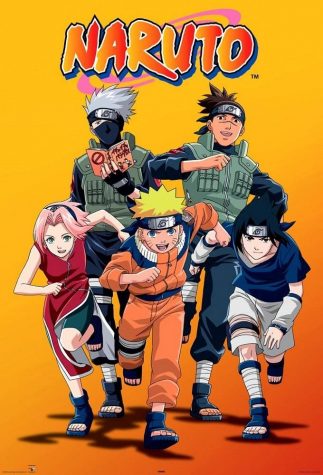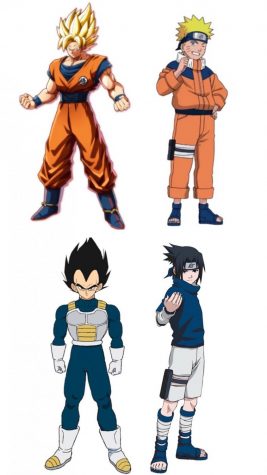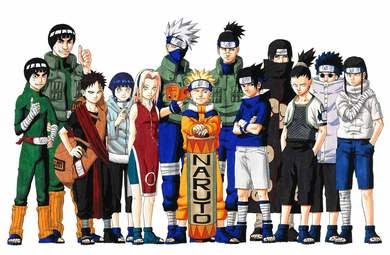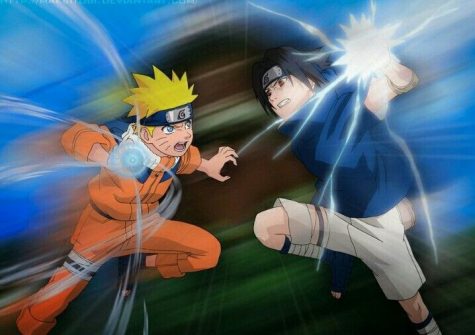When “Dragon Ball Z” finished its run in America in the late 90s, its popularity gave rise to a lot of anime that would be shown in the western world. As expected, many of them had a lot of focus on action, dynamic characters, and pushed the boundary in what could be done with their stories. Most were successful, others not so much, but either way a new breed of anime was on the rise. I say this because one of the most well-known series to come out in the early 2000s was an anime series called “Naruto.” Much like with “Dragon Ball” this show has had a large impact with hundreds of episodes, a ton of films, and even a sequel series. So how does it measure up? Let’s look at the premise.

The story centers on Naruto Uzumaki, a young knucklehead ninja who lives in the hidden leaf village of Konoha. He is often shunned and ignored by most people because years ago a fox demon called Nine Tails tried to destroy the village but was sealed inside Naruto as an infant. Wanting to prove himself as a force for good, Naruto makes it his goal to become Hokage, the leader of the village. Once Naruto graduates from the ninja academy, he joins Team 7 headed by elite shinobi (ninja) Kakashi Hatake. Naruto is also joined by Sasuke Uchiha, who wants to avenge his clan by killing his brother, and Sakura Haruno. Together they go on numerous missions honing their jutsu, as Naruto and Sasuke compete and fight alongside each other. The world they live in is populated with colorful characters, as well as villains who want to throw the other nations out of balance for their ends. Particularly the dangerous shinobi Orochimaru, who shows interest in Sasuke for his natural gifts. He offers Sasuke the power he needs to kill his older brother, which results in Naruto and his friends doing everything they can to stop Sasuke from going down a dark path.
Whenever people think of shonen anime, this is usually the type of show that comes to mind. In that, it focuses on the hero’s journey about an underdog with latent powers he didn’t know he had, and trains to hone his abilities as he fights stronger opponents along the way. If you liked “Dragon Ball” but wished it had ninjas, then this is up your alley.
It’s obvious that creator Masashi Kishimoto was heavily influenced by “Dragon Ball.” You can tell since both series share similar character archetypes, as well as humor. Some of the visual cues are obvious as well with Naruto loosely resembling Super Saiyan Goku’s appearance, and Sasuke resembling Vegeta. Both characters even share a similar frenemy rivalry that plays a major role throughout the series.

Even though its inspirations are obvious, “Naruto” was more grounded in its concept because it was able to tackle meaningful morals and themes that make for deep storytelling. Naruto being an outcast is already something people can identify with. There’s also the fact that he starts out as the least talented ninja of his class. While these are tropes we’ve seen done numerous times, you still want to see what they do with this character. Not only in how he matures, but also in how he literally learns to master his inner demon.
I also like how Naruto and Sasuke have similar backgrounds of having lost their families and are trying to accomplish their individual goals. With Naruto wanting to prove his worth, and Sasuke’s desire to avenge his family. Even though Sasuke is more respected by his peers because of his bloodline, he willingly distances himself from most people because of his tragic past. You see where both characters are coming from and understand why they make the choices they make. While you like seeing them interact with one another, you also want to see them go all out and see who comes out on top, which is what you would expect from a classic anime rivalry.
With that said, there are a few characters I wish were given more purpose. For example, Sakura’s character was not very interesting. Most of the other characters have multiple traits and arcs surrounding them, but for some reason, she’s mainly relegated to the love interest archetype. While they do have her do some action, and even give her an arc where she proves she’s useful, I feel like a lot more could have been done with this character. Eventually, they give her a major role near the end of the series, but I feel it could have been done a lot sooner.

This is ironic because a lot of the side characters in this series stand out the most to me. It could have been so easy to keep the complexity to the main characters. But a lot of them in some shape or form do have traits that help us identify with them. Characters such as Shikamaru, Rock Lee, Neji Hyuga, and Gaara all have interesting backgrounds and arcs that make for great character development. Much like with Naruto, a lot of them are looked down upon because of their life circumstances or limits their societies have placed on them. Some of them are hard to read at first, but once you get to know them, you get invested with how they progress and follow their own paths. It really ties into the theme of how each character is looking to find their place in the world, and break the mold in a system where their roles are seemingly predetermined.
It also helps that a lot of the characters’ dilemmas are centered around the conflicts in this series. The main one being centered on multiple shinobi nations that are on the brink of all-out war with one another. The series leads you to think that it’s peaceful at first, but you start to see how divided and unfair the world is as the story progresses. There’s this sense of political intrigue with how the ninja governments operate and make choices that are either for the greater good or to further themselves at the expense of other nations.
While that is true, it doesn’t go the usual route that big governments are purely bad, rather it’s used to show how those in positions of power have to make hard choices on what they believe will benefit their people. Even some of the good characters who want to do what is morally right are unable to because they have to fulfill roles in a system that keeps the peace but doesn’t always have everyone’s best interests.
The series also stands out with its action and combat. Most of it centers on each characters’ use of chakra and how they hone their jutsu to better sharpen their skills. The way it’s used is that each character does a series of hand signs to execute a special move or ability. It’s a simple idea that leads to a lot of creative action and ties directly into the series’ philosophies. It’s intricate and fascinating how each character thinks of different ways to use their techniques. It was more about strategy than who was physically stronger. A lot of it is centered on whose jutsu can beat what? Or what could counter an attack? If it’s ineffective at first, could it work from a different angle? If “Dragon Ball” combat was like arm wrestling, then this series feels more like chess play, which is more interesting because it surprises the audience by making characters think outside the box to get the upper hand in a situation.

I also want to point out that the way this series is organized feels like it’s part one of a larger narrative. In that, this show establishes characters and plotlines that are left open-ended to be continued in another series. For example, there’s an arc where Sasuke’s brother Itacchi returns and he’s part of this rogue shinobi group called the Akatsuki that are after Naruto for the Nine Tails. The characters have a small fight over it and it’s not touched upon again. You can tell that they introduced plotlines like this so that they can be continued and resolved in the future. This happens to be the case as the sequel series “Naruto: Shippuden” is where this conflict is part of the main focus.
Another thing I noticed was that after the final battle with Sasuke in episode 135, the remaining episodes of the series play out like filler episodes that don’t have a major impact on the narrative. While they are entertaining and have lots of character moments, I feel that if you want to continue with the main story you can just skip over to the last episode and go straight into “Naruto: Shippuden.”
Having seen a good portion of the first series, I can see why people gravitate to it so much. It has good characters, a creative world, and themes that anyone can connect with. It’s even carved a path for itself, inspiring other anime series with titles like “My Hero Academia” being notable examples. I can’t say it’s one of my die-hard favorites, but it is something that I do enjoy coming back to every once in a while. When I get to “Naruto: Shippuden” is still up in the air, as there are literally hundreds of episodes to cover. But it is something I look forward to viewing in the future. Put on your shinobi headband and allow this series to give you your shonen fix.

Rating: 5 / 5 Spinnaker Sails.
________
For more information or news tips, or if you see an error in this story or have any compliments or concerns, contact editor@unfspinnaker.com.















